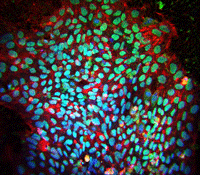Complex cell culture systems are emerging as key tools to improve physiological relevance of in vitro assay systems. There have been two main ways by which investigators attempt to improve mimicking of physiological conditions in cell and tissue culture. The first is to develop more complex model systems where two or more cell types are co-cultured in a 3D structure either separated by membranes or in spheroids [1]. The second is to incorporate fluidic-flow where the motion of the media itself has been shown to improve metabolic function and lifespan [2,3].
Despite the success of better recapitulating function at the cellular level using these two methods, neither of these approaches addresses the issue of the non-linear nature of the drug or toxicant exposure as is observed in an in vivo system [4]. As a result, the capacity to accurately predict in vivo pharmacokinetics and pharmacodynamics still falls short reaching at best 60-70% accuracy [5,6].
So what’s new in this area? We were interested to discover the following system, which we think will be of interest to many researchers. Let’s take a closer look at the characteristics and how it can be used.
SciFlow™ System: Multiwell Cascading Fluidics Cell Culture
The SciFlow™ dynamic culture system enables incorporation of physiological fluid flow in tissue culture assay systems for improving the physiological relevance of cell culture assays. The SciFlow™ plate is manufactured from polystyrene in an SBS standard microplate configuration modified to accommodate capillary channels that connect together 10 wells in each row (A through H). Controlled fluid flow improves the physiological relevance of existing cell-based assays and allows for new cell-based assays to be developed within a connected environmental system.

The SciFlow™ plate will enable you to…
- Form reagent gradients over time
- Connect multiple different tissues in series
- Perform constant fluid renewal over multiple day experiments
- Monitor experiments in real-time
- Harvest material during or at the end of experiments through accessible well configurations
Time resolved dynamic gradients
For solid tumor treatment, chemotherapeutics form a gradient where the tumor surface is exposed to more drug than the center. This gradient is both a function of diffusion through interstitial fluid as well as cellular metabolism and defense mechanisms of the tumor. This presents a challenge in creating dosing regimens that enable full penetration of the tumor without serious toxic side effects. SciFlow™ enables application of time resolved gradients in vitro.
Figure 2 shows the result of application of a 1uM solution of Fluorescien salt to the SciFlow source well. In this experiment, each well of SciFlow™ was filled with 100uL of complete media and allowed to fill the capillary channels. 1uM Fluorscein salt was then added to the source well. Measurements of the fluorescence at Ex/Em 485/525nm were acquired using a Tecan M1000 Infinite Pro instrument. Figure 2 left panel shows results from measurements every 30 minutes for approximately 470 minutes (8 hours). To extend the gradient over multiple days, 100uL media was removed from well 11 and 100ul fresh 1uM Fluorescein was applied to the source well. This was performed 2X per day for 3 days (76 hours) (Figure 2 right panel). The ability to form gradients over time from repeat dosing enables modeling 3D tumor biology in a 2D format.

Don’t miss our next posts on this subject! We’ll be back in the near future with application notes.
If you have any questions about using this system, leave them below and I’ll be pleased to answer.
References
- Godoy, P., et al., Arch Toxicol, 2013. 87(8): p. 1315-530.
- Vinci, B., et al., Biotechnol J, 2011. 6(5): p. 554-64.
- Domansky, K., et al., Lab Chip, 2010. 10(1): p. 51-8.
- Keenan, T.M. and A. Folch, Lab Chip, 2008. 8(1): p. 34-57.
- Wetmore, B.A., et al., Toxicol Sci, 2013. 132(2): p. 327-46.
- Yoon, M., et al., Crit Rev Toxicol, 2012. 42(8): p. 633-52.



